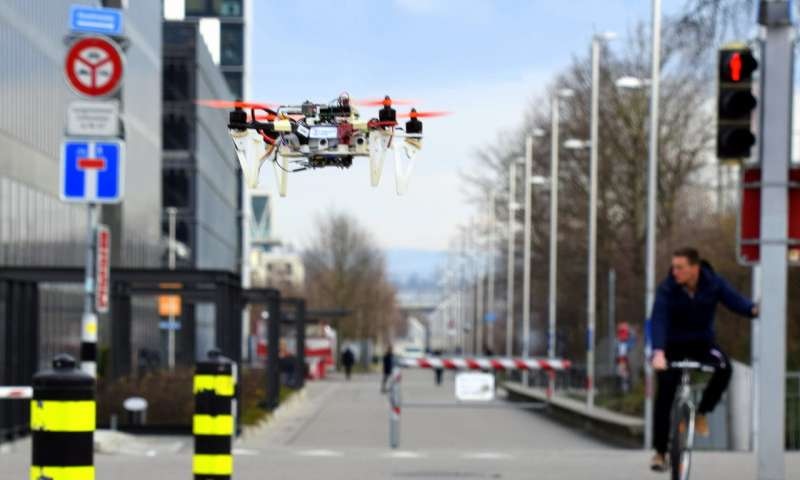Jan 25 2018
All present day commercial drones use GPS, which works well in high altitudes and above building roofs. But what about when drones have to steer independently at low altitude among tall buildings or in the dense, unstructured city streets with cyclists, cars or pedestrians unexpectedly crossing their way? Thus far, commercial drones are not able to swiftly react to such unanticipated events.
 By imitating cars and bicycles, the drone automatically learned to respect the safety rules. (Credit image: UZH)
By imitating cars and bicycles, the drone automatically learned to respect the safety rules. (Credit image: UZH)
Integrate Autonomously Navigating Drones
A team of researchers of the University of Zurich and the National Centre of Competence in Research NCCR Robotics developed DroNet, an algorithm that can safely steer a drone through city streets. Engineered as a fast eight-layer residual network, it creates two outputs for each input image: a steering angle to keep the drone navigating while avoiding impediments and a collision probability to let the drone recognize hazardous situations and quickly react to them.
DroNet recognizes static and dynamic obstacles and can slow down to avoid crashing into them. With this algorithm we have taken a step forward towards integrating autonomously navigating drones into our everyday life.
Davide Scaramuzza, Professor of Robotics and Perception
Powerful Artificial Intelligence Algorithm
Rather than depending on advanced sensors, the drone built by the Swiss researchers uses a regular camera like that of every smartphone and a very robust artificial intelligence algorithm to deduce the scene it observes and respond accordingly. The algorithm comprises a so-called Deep Neural Network.
This is a computer algorithm that learns to solve complex tasks from a set of ‘training examples’ that show the drone how to do certain things and cope with some difficult situations, much like children learn from their parents or teachers.
Davide Scaramuzza, Professor of Robotics and Perception
Cars and Bicycles Are the Drones’ Teachers
One of the toughest challenges in Deep Learning is to gather numerous ‘training examples’. To gain sufficient data to train their algorithms, Prof. Scaramuzza and his team gathered data from cars and bicycles that were driving in urban settings. By mimicking them, the drone automatically learned to heed the safety rules, such as “How to stop when obstacles like pedestrians, construction works or other vehicles block their ways” and “How to follow the street without crossing into the oncoming lane”. Even more remarkably, the researchers demonstrated that their drones learned to not only steer through city streets, but also in totally different environments where they were never trained to do so. The drones actually learned to fly independently in indoor environments, such as office’s corridors and parking lots.
Toward Fully Autonomous Drones
This research makes way for monitoring and surveillance or parcel delivery in chaotic city streets, as well as rescue operations in disaster-hit urban areas. However, the research team warns from exaggerated anticipations of what lightweight, inexpensive drones can do. “Many technological issues must still be overcome before the most ambitious applications can become reality,” says PhD student Antonio Loquercio.